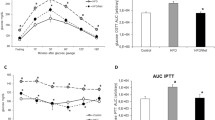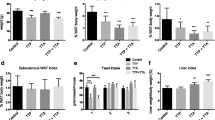Abstract
Mitochondrial dysfunctions have been detected in non-alcoholic steatohepatitis, but less information exists regarding adaptation of mitochondrial function during the initiation of hepatic steatosis. This study aimed to determine in rat liver the sequence of mitochondrial and metabolic adaptations occurring during the first 8 weeks of a moderate high fat diet (HFD). Sprague–Dawley rats were fed a HFD during 2, 4, and 8 weeks. Mitochondrial oxygen consumption, respiratory chain complexes activity, and oxidative phosphorylation efficiency were assessed in isolated liver mitochondria. Gene expression related to fat metabolism and mitochondrial biogenesis were determined. Results were compared to data collected in a group of rats sacrificed before starting the HFD feeding. After 2 and 4 weeks of HFD, there was a development of fatty liver and a concomitant increase the expression of mitochondrial glycerol-3-phosphate acyltransferase (mtGPAT) and peroxisome proliferator-activated receptor γ. Higher serum β-hydroxybutyrate levels and enhanced hepatic pyruvate dehydrogenase kinase 4 expression suggested increased fatty acid oxidation. However, mitochondrial respiration and respiratory chain activity were normal. After 8 weeks of HFD, lower accumulation of liver triglycerides was associated with reduced expression of mtGPAT. At this time, oxygen consumption with palmitoyl-l-carnitine was decreased whereas oxidative phosphorylation efficiency (ATP/O) with succinate was enhanced. Hepatic levels of mtDNA were unchanged whatever the time points. This longitudinal study in rats fed a HFD showed that hepatic lipid homeostasis and mitochondrial function can adapt to face the increase in fatty acid availability.




Similar content being viewed by others
Abbreviations
- HFD:
-
High fat diet
- RCR:
-
Respiratory control ratio
- CS:
-
Citrate synthase
- TG:
-
Triglyceride
- mtDNA:
-
Mitochondrial DNA
- HPRT:
-
Hypoxanthine guanine phosphoribosyl transferase
- PGC1α and β:
-
Peroxisome proliferator-activated receptor γ coactivator 1 α and β
- TFAM:
-
Mitochondrial transcription factor A
- NRF1:
-
Nuclear respiratory factor 1
- ERRα:
-
Estrogen-related receptor α
- SCD1:
-
Stearoyl-coenzyme A desaturase 1
- mtGPAT:
-
Mitochondrial glycerol-3-phosphate acyltransferase
- PPARα and γ:
-
Peroxisome proliferator-activated receptor α and γ
- CPT1:
-
Carnitine palmitoyltransferase 1
- PDK4:
-
Pyruvate dehydrogenase kinase 4
References
Bedoucha M, Atzpodien E, Boelsterli UA (2001) Diabetic KKAy mice exhibit increased hepatic PPARgamma1 gene expression and develop hepatic steatosis upon chronic treatment with antidiabetic thiazolidinediones. J Hepatol 35:17–3
Ciapaite J, Bakker SJ, Van Eikenhorst G et al (2007) Functioning of oxidative phosphorylation in liver mitochondria of high-fat diet fed rats. Biochim Biophys Acta 1772:307–316
Crescenzo R, Bianco F, Falcone I et al (2008) Alterations in hepatic mitochondrial compartment in a model of obesity and insulin resistance. Obesity (Silver Spring) 16:958–64
Flamment M, Arvier M, Gallois Y et al (2008) Fatty liver and insulin resistance in obese Zucker rats: no role for mitochondrial dysfunction. Biochimie 90:1407–13
Forcheron F, Abdallah P, Basset A et al (2009) Nonalcoholic hepatic steatosis in Zucker diabetic rats: spontaneous evolution and effects of metformin and fenofibrate. Obesity 17:1381–9
Fromenty B, Pessayre D (1995) Inhibition of mitochondrial beta-oxidation as a mechanism of hepatotoxicity. Pharmacol Ther 67:101–54
Fromenty B, Robin MA, Igoudjil A et al (2004) The ins and outs of mitochondrial dysfunction in NASH. Diabetes Metab 30:121–38
García-Ruiz C, Colell A, Morales A et al (1995) Role of oxidative stress generated from the mitochondrial electron transport chain and mitochondrial glutathione status in loss of mitochondrial function and activation of transcription factor nuclear factor-kappa B: studies with isolated mitochondria and rat hepatocytes. Mol Pharmacol 48:825–34
Gauthier MS, Favier R, Lavoie JM (2006) Time course of the development of non-alcoholic hepatic steatosis in response to high-fat diet-induced obesity in rats. Br J Nutr 95:273–81
Gavrilova O, Haluzik M, Matsusue K et al (2003) Liver peroxisome proliferator-activated receptor gamma contributes to hepatic steatosis, triglyceride clearance, and regulation of body fat mass. J Biol Chem 278:34268–76
Hedley AA, Ogden CL, Johnson CL et al (2004) Prevalence of overweight and obesity among US children, adolescents, and adults, 1999–2002. JAMA 291:2847–50
Inoue M, Ohtake T, Motomura W et al (2005) Increased expression of PPARgamma in high fat diet-induced liver steatosis in mice. Biochem Biophys Res Commun 336:215–22
Malgat M, Durrieu G, Mazat JP (1999) Enzymatic and polarographic measurements of the respiratory chain complexes. In: Lestienne P (ed) Mitochondrial diseases. Springer, Paris, pp 357–77
Memon RA, Tecott LH, Nonogaki K et al (2000) Up-regulation of peroxisome proliferator-activated receptors (PPAR-alpha) and PPAR-gamma messenger ribonucleic acid expression in the liver in murine obesity: troglitazone induces expression of PPAR-gamma-responsive adipose tissue-specific genes in the liver of obese diabetic mice. Endocrinology 141:4021–31
Mootha VK, Handschin C, Arlow D et al (2004) Erralpha and Gabpa/b specify PGC-1alpha-dependent oxidative phosphorylation gene expression that is altered in diabetic muscle. Proc Natl Acad Sci USA 101:6570–5
Morino K, Petersen KF, Shulman GI (2006) Molecular mechanisms of insulin resistance in humans and their potential links with mitochondrial dysfunction. Diabetes 55:S9–S15
Nogueira V, Piquet MA, Devin A et al (2001) Mitochondrial adaptation to in vivo polyunsaturated fatty acid deficiency: increase in phosphorylation efficiency. J Bioenerg Biomembr 33:53–61
Prentice AM (2006) The emerging epidemic of obesity in developing countries. Int J Epidemiol 35:93–9
Rahimian R, Masih-Khan E, Lo M et al (2001) Hepatic over-expression of peroxisome proliferator activated receptor gamma2 in the ob/ob mouse model of non-insulin dependent diabetes mellitus. Mol Cell Biochem 224:29–37
Rolfe DF, Brown GC (1997) Cellular energy utilization and molecular origin of standard metabolic rate in mammals. Physiol Rev 77:731–58
Rossignol R, Letellier T, Malgat M et al (2000) Tissue variation in the control of oxidative phosphorylation: implication for mitochondrial diseases. Biochem J 347:45–53
Rustin P, Chretien D, Bourgeron T et al (1994) Biochemical and molecular investigations in respiratory chain efficiencies. Clin Chim Acta 228:35–51
Schreiber SN, Emter R, Hock MB et al (2004) The estrogen-related receptor alpha (ERRalpha) functions in PPARgamma coactivator 1alpha (PGC-1alpha)-induced mitochondrial biogenesis. Proc Natl Acad Sci USA 101:6472–7
Schreiber SN, Knutti D, Brogli K et al (2003) The transcriptional coactivator PGC-1 regulates the expression and activity of the orphan nuclear receptor estrogen-related receptor alpha (ERRalpha). J Biol Chem 278:9013–8
Serviddio G, Bellanti F, Tamborra R et al (2008) Alterations of hepatic ATP homeostasis and respiratory chain during development of non-alcoholic steatohepatitis in a rodent model. Eur J Clin Invest 38:245–52
Sugden MC (2003) PDK4: a factor in fatness? Obes Res 11:167–9
Sul HS, Wang D (1998) Nutritional and hormonal regulation of enzymes in fat synthesis: studies of fatty acid synthase and mitochondrial glycerol-3-phosphate acyltransferase gene transcription. Annu Rev Nutr 18:331–51
World Health Organization (2000) Obesity: preventing and managing the global epidemic. Report of a WHO consultation. World Health Organ. Tech Rep Ser 894: i-xii, 1–253
Xu H, Wilcox D, Nguyen P et al (2006) Hepatic knockdown of mitochondrial GPAT1 in ob/ob mice improves metabolic profile. Biochem Biophys Res Commun 349:439–48
Zhang Y, Ma K, Sadana P et al (2006) Estrogen-related receptors stimulate pyruvate dehydrogenase kinase isoform 4 gene expression. J Biol Chem 281:39897–906
Acknowledgments
Melissa Flamment was supported by a grant from "Conseil Régional Pays de la Loire/Inserm". The authors thank Jerome Roux, Pierre Legras, and Laurent Buffet for animal care.
Authors’ contributions
Mélissa Flamment conducted all the study, with the help of Naig Gueguen and Gilles Simard for mitochondrial respiration. Jennifer Rieusset and Hubert Vidal did the gene expression quantifications. Yves Malthiery, Bernard Fromenty, and Pierre-Henri Ducluzeau were involved in the design and the manuscript writing.
Author information
Authors and Affiliations
Corresponding author
Rights and permissions
About this article
Cite this article
Flamment, M., Rieusset, J., Vidal, H. et al. Regulation of hepatic mitochondrial metabolism in response to a high fat diet: a longitudinal study in rats. J Physiol Biochem 68, 335–344 (2012). https://doi.org/10.1007/s13105-012-0145-3
Received:
Accepted:
Published:
Issue Date:
DOI: https://doi.org/10.1007/s13105-012-0145-3




